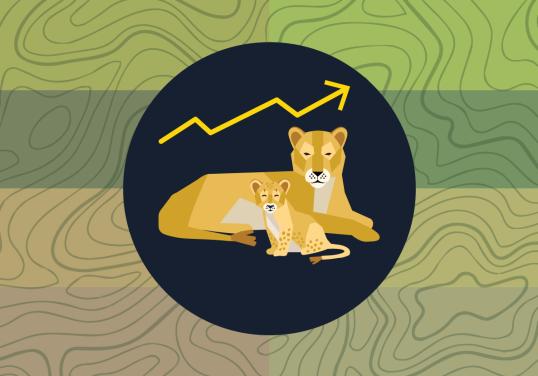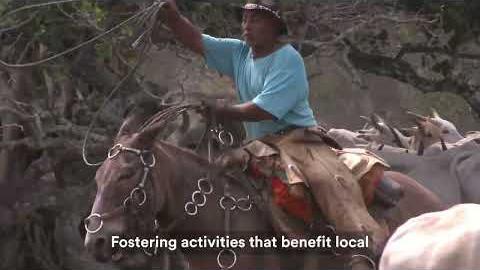About Lions
Lions (Panthera leo) symbolize power and strength across Africa and parts of Asia. Yet few realize that these big cats have undergone a catastrophic range reduction of 95 percent, with only about 24,000 lions remaining, down from an estimated 200,000, because of poaching for the illegal wildlife trade, habitat loss and human-wildlife conflict. However, enough habitat still exists to recover their numbers substantially, so we must act now. Together, we can stabilize and recover lion populations by protecting and connecting key populations throughout Africa and improving coexistence between lions and humans.
Our goal is to secure or re-establish a minimum of eight lion populations, that are trending towards carrying capacity, within globally or regionally significant landscapes by 2030.
Panthera's Lion Program
Panthera’s lion program operates four landscape-scale population recovery projects in four countries. We also engage in lion conservation policy range-wide and assist other NGOs and governments with lion surveys and lion-human conflict mitigation. In some of these sites, lion populations are stabilizing or even increasing. Building on recent, replicable success stories for recovering lion populations, lion populations are likely rebounding in Zambia’s Kafue National Park thanks to four years of rigorous counter-poaching operations that employ conservation technologies led by Zambia’s Department of National Parks and Wildlife. In another victory, Panthera and Senegal’s Directorate of National Parks have helped double the population of Critically Endangered West African lions, from between 10 and 15 in 2017 to 30 in Niokolo-Koba National Park.
Our Goals

Secure or re-establish a minimum of eight lion populations, that are trending towards carrying capacity, within globally or regionally significant landscapes by 2030.
Where Do Lions Live?
Lions can live in a wide variety of habitats, including open woodland and grass savannas as well as dry forests, coastal scrub and semi-desert areas. The vast majority live in sub-Saharan Africa, with a small population in India.
Where We Work
Gabon: Panthera supports research on the last remaining lion, wildlife markets and the potential reintroduction of the species.
Senegal: Alongside partners, we implement advanced wildlife monitoring technologies and targeted field activities to monitor, protect and restore the remaining Critically Endangered West African lions.
Zambia: In five intensive protection zones, we employ advanced field techniques to monitor populations of lions and leopards alongside the Department of National Parks and Wildlife and a team of six NGOs. Learn more about our work in Kafue National Park.
Zimbabwe: We work with Wilderness Safaris to support an antipoaching team that removes wire snares from important lion habitat in the Eastern part of Hwange National Park, thereby protecting lions and lion prey species.
- Historic Range
- Current Range
FAQs
How many lions are left in the wild?
Only an estimated 24,000 wild lions remain. Recent research from Panthera’s Lion Director and Oxford University’s Wildlife Conservation Research Unit estimates the global lion population was as large as 200,000 in 1900 and that it decreased to 90,000 in 1970.
Why do lions have manes?
Lions are the only wild cat species to develop manes. They not only signal their genetic fitness to females, but also make them appear larger and more dominating to competitors. Females show preferences for bigger, darker manes. Male lions with these traits will then mate more and pass on those genes more frequently.
What do lions eat?
Prides can hunt and kill even the largest herbivores, such as buffalo, giraffes and even elephant juveniles. However, they more commonly hunt and feed on smaller to medium-sized species like wildebeest, zebra, impala and warthog.
Can lions purr?
Most big cats, including lions, cannot purr. Instead, they are known for their famous roars. This iconic vocalization occurs when lions exhale forcefully and is made possible by the hyoid bone in the cat’s throat, which is attached to a specialized stretching ligament.
What are the threats facing lions?
The species is threatened by the illegal wildlife trade which targets their meat and other body parts, habitat loss and fragmentation and human-cat conflict due to the real or perceived threat that lions pose to livestock.
How can we save lions and what can I do to help?
Donating to Panthera helps further our lion protection efforts in four countries, along with protecting other wild cat species around the world. Together, we can help save lions by preserving their habitats, protecting them and their prey from poaching and illegal hunting, and helping communities coexist alongside them.






